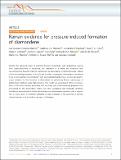| dc.contributor.author | Martins, Luiz Gustavo Pimenta | |
| dc.contributor.author | Matos, Matheus J. S. | |
| dc.contributor.author | Paschoal, Alexandre R. | |
| dc.contributor.author | Freire, Paulo T. C. | |
| dc.contributor.author | Andrade, Nadia F. | |
| dc.contributor.author | Aguiar, Acrísio L. | |
| dc.contributor.author | Kong, Jing | |
| dc.contributor.author | Neves, Bernardo R. A. | |
| dc.contributor.author | de Oliveira, Alan B. | |
| dc.contributor.author | Mazzoni, Mário S.C. | |
| dc.contributor.author | Filho, Antonio G. Souza | |
| dc.contributor.author | Cançado, Luiz Gustavo | |
| dc.date.accessioned | 2018-02-13T20:32:41Z | |
| dc.date.available | 2018-02-13T20:32:41Z | |
| dc.date.issued | 2017-07 | |
| dc.date.submitted | 2016-11 | |
| dc.identifier.issn | 2041-1723 | |
| dc.identifier.uri | http://hdl.handle.net/1721.1/113640 | |
| dc.description.abstract | Despite the advanced stage of diamond thin-film technology, with applications ranging from superconductivity to biosensing, the realization of a stable and atomically thick two-dimensional diamond material, named here as diamondene, is still forthcoming. Adding to the outstanding properties of its bulk and thin-film counterparts, diamondene is predicted to be a ferromagnetic semiconductor with spin polarized bands. Here, we provide spectroscopic evidence for the formation of diamondene by performing Raman spectroscopy of double-layer graphene under high pressure. The results are explained in terms of a breakdown in the Kohn anomaly associated with the finite size of the remaining graphene sites surrounded by the diamondene matrix. Ab initio calculations and molecular dynamics simulations are employed to clarify the mechanism of diamondene formation, which requires two or more layers of graphene subjected to high pressures in the presence of specific chemical groups such as hydroxyl groups or hydrogens. | en_US |
| dc.publisher | Nature Publishing Group | en_US |
| dc.relation.isversionof | http://dx.doi.org/10.1038/S41467-017-00149-8 | en_US |
| dc.rights | Creative Commons Attribution 4.0 International License | en_US |
| dc.rights.uri | https://creativecommons.org/licenses/by/4.0/ | en_US |
| dc.title | Raman evidence for pressure-induced formation of diamondene | en_US |
| dc.type | Article | en_US |
| dc.identifier.citation | Martins, Luiz Gustavo Pimenta et al. “Raman Evidence for Pressure-Induced Formation of Diamondene.” Nature Communications 8, 1 (July 2017) © 2017 The Author(s) | en_US |
| dc.contributor.department | Massachusetts Institute of Technology. Department of Electrical Engineering and Computer Science | en_US |
| dc.contributor.mitauthor | Kong, Jing | |
| dc.relation.journal | Nature Communications | en_US |
| dc.eprint.version | Final published version | en_US |
| dc.type.uri | http://purl.org/eprint/type/JournalArticle | en_US |
| eprint.status | http://purl.org/eprint/status/PeerReviewed | en_US |
| dc.date.updated | 2018-02-09T15:29:49Z | |
| dspace.orderedauthors | Martins, Luiz Gustavo Pimenta; Matos, Matheus J. S.; Paschoal, Alexandre R.; Freire, Paulo T. C.; Andrade, Nadia F.; Aguiar, Acrísio L.; Kong, Jing; Neves, Bernardo R. A.; de Oliveira, Alan B.; Mazzoni, Mário S.C.; Filho, Antonio G. Souza; Cançado, Luiz Gustavo | en_US |
| dspace.embargo.terms | N | en_US |
| dc.identifier.orcid | https://orcid.org/0000-0003-0551-1208 | |
| mit.license | PUBLISHER_POLICY | en_US |
